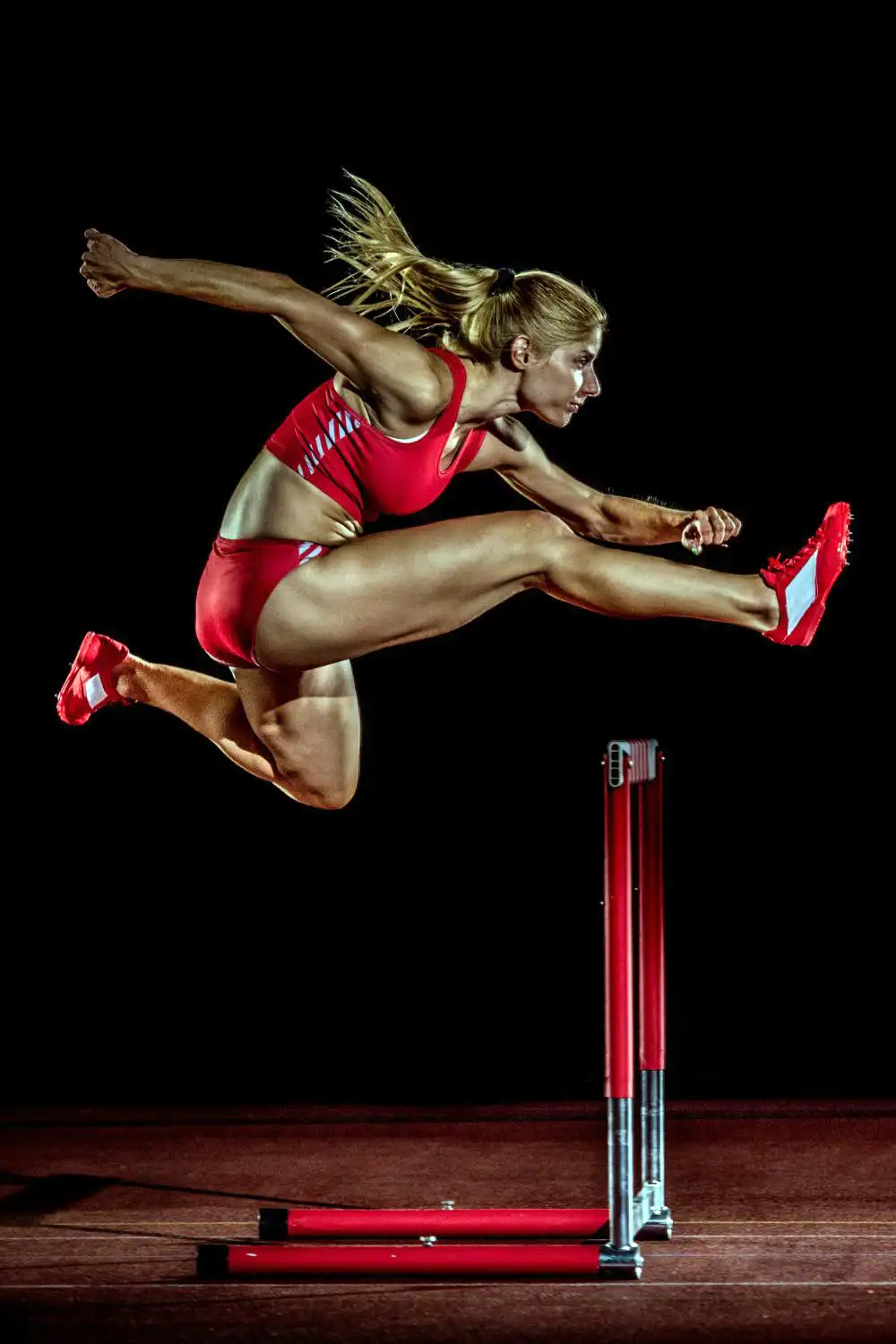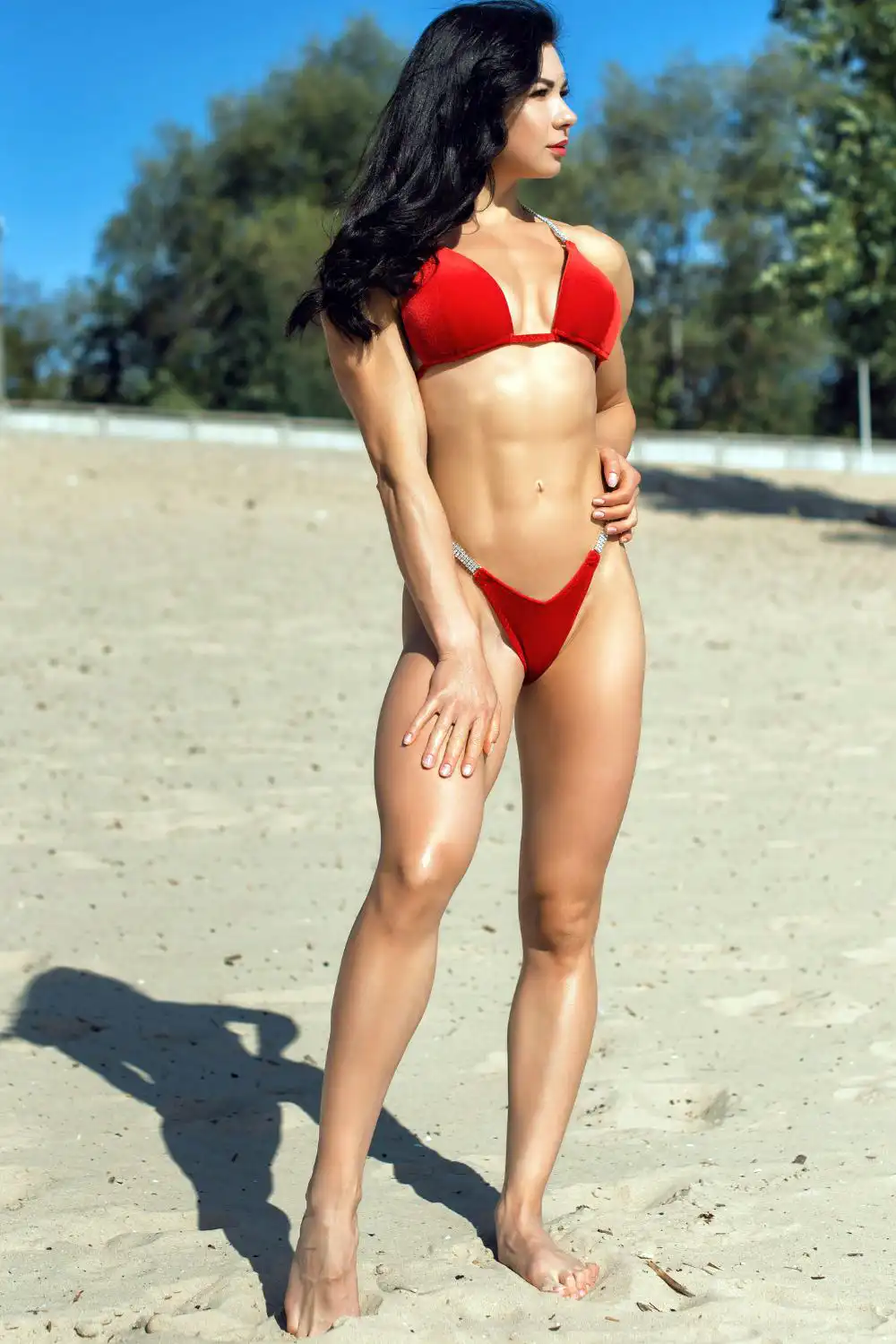Bikinis have become synonymous with female track and field athletes, but the reasons why so many runners compete in this two-piece attire go beyond aesthetics. First and foremost, comfort and freedom of movement reign supreme – bikinis provide an airy, lightweight fit that allows athletes’ muscles to move unrestricted.
This comfort and lack of bulk enable better performance on the track, with less chafing, less fatigue, and improved aerodynamics. Staying cool in the heat also drives some runners’ preference for bikinis, with breathable fabrics that wick sweat and maximize air circulation.
Yet beyond mere practicality, the minimal attire can be empowering – highlighting female athletes’ strength, endurance, and physique gained through rigorous training.
However, not all runners choose bikinis nor feel their sport should dictate women “must” wear them. Some argue bikinis can sexualize rather than celebrate female athletes’ physical capabilities.
Ultimately while bikinis comply with regulations when worn, true progress requires giving women the freedom to select uniforms based on performance priorities rather than defaulting to tradition or aesthetics.
When female track athletes have a say in their attire, they can focus energy instead of showcasing pure athletic brilliance on the track. So, let’s check out all reasons deeply.
Why do female track athletes wear bikinis?
Reduces wind resistance and helps athletes run faster
Female track athletes often wear bikini bottoms while competing to gain an aerodynamic advantage. Bikini bottoms are designed to reduce drag and wind resistance by minimizing fabric, similar to the streamlined design of airplanes and race cars.
The lack of material in bikinis helps athletes become more aerodynamic and reduces friction against the air while running, allowing them to reach higher speeds and improve their performance times.
The minimal lower body coverage of bikini bottoms also helps the athletes’ muscles work freely without any fabric getting in the way of their motion, enhancing their speed and mobility on the track field.
In summary, female track athletes wear bikinis during competitions to achieve maximum aerodynamics and less resistance from wind and fabric, which translates to better performance and more advantages over opponents.

Provides comfort and allows for unrestricted movement
Female track athletes often wear bikini bottoms during competitions for comfort and freedom of movement. Bikinis provides a loose and relaxed fit that does not restrict the movement of leg muscles. They have material only where necessary, leaving plenty of room for the athletes’ legs to move freely and comfortably during running.
The lightweight fabric of bikini bottoms allows athletes to run without feeling weighed down or constricted, keeping them comfortable, cool, and dry during races.
The minimal lower body coverage of bikini bottoms helps the athletes’ muscles perform at their best without any fabric hindering their natural motion.
In short, female track athletes wear bikinis while competing because they provide an optimal balance of comfort, fitness, and freedom of movement needed for optimal athletic performance.
Keeps athletes cool and dry in hot weather
Female track athletes often choose to wear bikini bottoms while competing to stay cool in hot weather. Bikinis provide minimal coverage, allowing for better air circulation and heat dissipation.
The lack of material exposes more of the athletes’ skin to the air, helping them release body heat more easily and stay cool during demanding exercises in warm conditions. The lightweight fabric and spaghetti straps of bikini bottoms also help keep athletes dry and ventilated so perspiration can evaporate quickly.
The frequent need to train and compete in hot, sunny environments makes bikinis a practical choice for many female track and field athletes. The design allows for maximum airflow and ventilation needed to prevent overheating, muscle fatigue, and loss of performance caused by high temperatures.
In summary, bikini bottoms are suitable competition wear for female athletes in hot weather because their minimal and open style keeps the body cooler, drier, and more comfortable during intense physical activity under the sun.
Supports muscle recovery and prevents fatigue
Female track athletes often choose to wear bikini bottoms while competing because of the health benefits they provide for their muscles. In addition to comfort and freedom of movement, the minimal design of bikinis allows for increased oxygen flow to leg muscles during and after running.
The lack of restrictive fabric exposes more of the athletes’ skin, promoting better air circulation and oxygen delivery to working muscles. This helps relax strained leg muscles, reduces fatigue and soreness, and speeds up recovery between training sessions and competitions.
The increased oxygen flow enabled by the open bikini bottom design aids in removing waste products like lactic acid that build up in leg muscles during strenuous exercise. This supports muscle recovery and prevents athletes from reaching a point of fatigue too quickly during races.
In summary, the lack of fabric and minimal coverage of bikini bottoms allows the body to self-regulate temperature, receive optimum oxygen circulation, and eliminate waste products more efficiently from leg muscles.
These factors contribute to quicker recovery, reduced muscle fatigue, and improved athletic performance for female track athletes who wear this bikini style during competitions.
Showcases athleticism and physical fitness
Female track athletes sometimes choose to wear bikinis during competitions to showcase their athleticism and physical fitness. The minimal clothing highlights their toned physiques and muscular legs gained through intensive training, visually representing their dedication and achievement in sports.
However, some female track athletes have criticized being required to wear bikini bottoms, arguing they feel unnecessarily sexualized and uncomfortable in such attire.
Pole vaulter, Holly Bradshaw refused to wear a crop top and bikini shorts at the Olympics. Since Tokyo, many women athletes have contacted her, expressing how such outfits deterred them from competing in track and field.
While bikinis can draw attention to an athlete’s physique and fitness level, the attire has also prompted debates about the inappropriate sexualization of female athletes.
Many argue that women should have the option – not an obligation – to choose performance-enhancing uniforms that make them feel secure and empowered rather than exploited. Track outfits for female athletes should primarily be evaluated based on performance, comfort, and practical needs rather than focusing on aesthetics and the sexualization of women’s bodies.
Ultimately more options that allow female athletes freedom of choice in attire could help promote an inclusive culture that celebrates women’s athletic achievements above all.
Represents the tradition and culture of track and field
Female track athletes often wear bikini bottoms during competitions to adhere to the tradition and culture of their sport. Wearing minimal clothing has been a longstanding practice in track and field, signifying its history and established norms.
Bikinis have been part of the official dress code for female track athletes at major competitions for many years and have become symbolic of the sport’s tradition.
Track and field is an established sport with set rules and protocols across international competitions regarding uniforms and attire. The bikini-bottom style uniforms for women have remained largely unchanged over time.
By adhering to the typical dress code requirements, female athletes signify that they are part of the broader track and field community and demonstrate commitment to historical conventions within the sport.
However, some athletes have pushed back against wearing bikinis, arguing they can feel sexualized, and degraded and that the attire prioritizes aesthetics over performance needs.
While wearing bikinis aligns female athletes with a form of traditional presentation within track and field, there is a growing movement for more inclusive uniforms that allow women freedom of choice.
Rather than focusing solely on tradition, advocates argue that the primary considerations for female track attire should involve practical performance benefits, comfort, and the individual athlete’s preferences.
Minimizes weight and bulkiness for better performance
Female track athletes often choose to wear bikinis while competing because they are lightweight and minimize bulk, enabling better performance. The minimal design of bikini bottoms reduces excess fabric and material compared to other bottom styles like shorts or leggings.
The lightweight and unrestricted fit of a bikini allows athletes’ legs to move more freely without being weighed down, facilitating better performance during running. Bikini bottoms are designed using just enough fabric to cover the essential areas, eliminating extra weight that could slow an athlete’s pace or tire muscles more quickly.
The lack of extra material and seams in bikinis also helps prevent chafing of athletes’ thighs that could occur from the movement of bulkier layers of clothing during running. This further contributes to comfort and reduces the risks of pain and irritation.
In summary, female track athletes often select bikini bottoms as their competition wear because the lightweight design, limited material, and lack of bulk allow their leg muscles to function as efficiently as possible.
The minimized weight and streamlined style of bikinis enhance performance by letting athletes’ bodies move freely and quickly without being weighed down by excess fabric.

Gives athletes a choice in their uniform
Female track athletes often wear bikinis during competitions because it allows them to select an outfit they feel confident and comfortable competing in. Track athletes can choose the best uniform for their performance needs and preferences.
For some athletes, bikini bottoms are a preferred choice due to the performance advantages they offer. The lightweight fabric and lack of excess material in bikinis can help athletes run more freely and efficiently without being weighed down.
However, not all female track athletes choose to wear bikini bottoms. The option of wearing more covered attire empowers athletes who do not feel comfortable racing partially nude.
Ultimately, track outfits for female athletes should primarily be evaluated based on what best enables performance, not aesthetic preferences. Having various options in competition uniforms that allow women freedom of choice can help promote an inclusive culture that focuses on athletic ability rather than outward appearance.
When female track athletes can select the competition attire that makes them feel most secure, self-assured, and prepared, they can compete to the best of their abilities regardless of their outfits.
Meets regulations and guidelines of sports federations
Female track athletes often wear bikinis during competitions because they comply with the rules and regulations set by sports governing bodies. Most track and field competitions have dress code guidelines regarding appropriate clothing for athletes.
The International Amateur Athletic Federation and individual event organizers typically specify requirements for females’ uniforms, including limits on length and coverage. Bikinis worn by athletes fall within these regulated parameters, meeting the standards for acceptable competition attire.
Complying with the official guidelines helps ensure fairness in competition and prevents athletes from gaining an inappropriate advantage from their outfit choice. The regulations aim to maintain integrity in the sport by having a basic level of uniformity in competition wear for female track athletes.
While bikini bottoms meet regulated standards, not all female athletes prefer this style. Some have advocated for less restrictive guidelines and more options in competition uniforms.
There have also been debates about whether the regulations emphasize the sexualization of women’s bodies rather than prioritizing performance needs.
Overall, track outfits for female athletes should enable them to compete comfortably and fairly while complying with the basic rules set by sports federations.
Having a range of options that allow women choices within these guidelines could help promote a more inclusive culture that fairly evaluates athletic performance above all.
Enhances blood circulation and skin health
Female track athletes sometimes choose to wear bikini bottoms during competitions because the design can enhance blood circulation in the legs and promote skin health.
The minimal coverage and lightweight fabric of bikinis allow for maximum airflow and skin exposure on the legs. This helps improve blood circulation as athletes run, with more oxygen and nutrients delivered to skin cells via increased blood flow.
The better blood circulation enabled by bikini bottoms aids the body in removing toxins and waste products from the skin. This helps expel substances that can cause acne, inflammation, or rashes if trapped beneath the skin for too long.
The improved oxygen delivery to the skin and elimination of toxins supports overall skin health and helps prevent conditions like rashes and irritation that could form from sweat, chafing, or bacterial growth during intense exercise.
However, enhancing blood circulation and skin health are not the primary reasons most female track athletes choose bikinis. Comfort, freedom of movement, and potential performance benefits are typically more influential factors in their uniform selections.
While bikini bottoms may offer some skin health advantages, many female athletes also push for options beyond bikinis that allow them to prioritize practical needs over appearance-based concerns.
Alternatives for female athletes to wear skimpy outfits
Here are the alternatives for female athletes to wear instead of skimpy bikini outfits during competitions:
Female track and field athletes have several options for competition wear instead of traditional bikini bottoms and crop tops. Shorts, leggings, skirts, athletic pants, tank tops, and rash guards can provide fuller coverage that some women prefer while still meeting most sports’ uniform regulations.
Shorts
Shorts are a common alternative. Track shorts for women are typically tight and above the knee for comfort and mobility while running. They offer more coverage of the legs than bikinis, yet are still made of lightweight, breathable fabrics that keep athletes cool. Some sports now allow female competitors the option to wear shorts instead of bikini bottoms.
Leggings
Leggings are another comfortable alternative, providing full coverage of the legs in a stretchy material that does not impede movement. Women can wear leggings alone or underneath shorts or a skirt for races.
Skirts
Skirts are an attractive uniform option for some female athletes. Performance skirts come in different lengths and fabrics, ranging from casual to form-fitting styles, with built-in shorts providing support and coverage under the skirt layer.
Athletic pants
Full-length athletic pants made especially for women offer full coverage of the legs while still being lightweight, sweat-wicking, and stretchy enough not to limit the range of motion. Some styles incorporate built-in shorts for added support.
Rash guards
Instead of crop tops, Rash guards provide full coverage of the arms and torso in a lightweight, breathable fabric that protects skin from the sun during training and competition. Rash guards can be worn alone or under tank tops or sports bras.
Tank tops
Loose-fitting tank tops offer more coverage than crop tops but are still designed for comfort and mobility using breathable fabrics. Some incorporate built-in bras for support during physical activity.
While some sports still have strict regulations requiring bikini-style uniforms, many are revising guidelines to allow women competitors to cover up more if preferred. Ultimately, female athletes should be free to choose competition wear that makes them feel comfortable and confident rather than being obligated to wear sexualized uniforms.
In summary, shorts, leggings, skirts, athletic pants, rash guards, and loose-fitting tank tops can provide female track athletes alternatives to skimpy bikinis during competition, balancing coverage, comfort, and performance needs – giving women greater choice and empowerment in their sport.

Summary
Female track and field athletes often wear bikinis during competitions for various reasons. The primary motive is the comfort and freedom of movement that bikinis provide, allowing their muscles to move unrestricted. Bikinis are lightweight, minimizing bulkiness and helping athletes perform better.
They also help athletes stay cool and dry in hot weather by maximizing airflow and heat dissipation. Bikinis can showcase athleticism and physical fitness, although some argue they sexualize female athletes. Wearing bikinis represents the tradition and culture of track and field, but there is a growing movement for more inclusive uniform options.
Bikinis are preferred because they minimize weight, reduce drag and friction, and they comply with sports federation regulations. Additionally, the design of bikinis enhances blood circulation and skin health. Ultimately, the focus should be on performance and athlete preference rather than defaulting to tradition or aesthetics.
FAQ
Why do female runners wear bun huggers?
Some runners prefer bun huggers because they are more feminine and professional-looking than longer shorts.
Why do female runners wear such short shorts?
The primary reason that runners wear short shorts is to avoid chafing when running. The more cloth there is, the more friction there is. This is exacerbated by a greater cadence, stride length, running time, and the outside temperature. As a result, the less cloth you can use, the better.
What do female track athletes wear under their shorts?
Some athletes wear compression shorts made of lycra-type material to prevent chafing and provide support. Others may wear regular underwear or sports bras.



